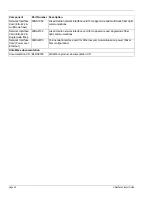
Page 42
UltraWave Product Guide
UltraWave testing
The amount and type of testing depend on your security requirements and installation.
•
High Security Zone - detection of an intruder stomach-crawling perpendicular to the beam,
and log rolling parallel to the beam.
•
Medium Security Zone - detection of an intruder crawling on hands and knees.
•
Low Security Zone - detection of an upright walking intruder (beam-break alarm).
To ensure the required level of detection, you should simulate the worst case scenario for your
type of installation following the semi-annual recalibration (see
System verification tests on page
Beam-break alarm test
Depending on your site-specific security requirements, Senstar recommends conducting a
beam-break alarm test:
•
daily for high security applications,
•
weekly for medium security applications,
•
monthly for low security applications.
To conduct a beam-break alarm test walk through the UltraWave zone at any point in the zone.
The test is successful if the receiver unit signals a microwave alarm in response to the test.
Remote self-test
If your UltraWave system is configured for remote self-test, the self-test should be activated at
least once per day.
For UltraWave systems that operate in Local control mode, press and hold the momentary switch
input for approximately two seconds (the switch must be closed for a minimum of the time
specified in the Filter Window parameter). The self-test is successful if the receiver signals a
microwave alarm.
For UltraWave systems that operate in Remote control mode, use the security management
system to activate the self-test input. The self-test is successful if the receiver signals a microwave
alarm.
Correcting nuisance alarm problems
If an UltraWave system is encountering a high nuisance alarm rate (NAR) you need to determine
the source of the alarms and correct the problem. Begin by reviewing the site planning and design
section in Chapter 1. Ensure that the installation rules have been followed, and the mounting
height, mounting angle, and required area of clearance for the detection zone are correct.
After verifying that installation problems are not the source of the nuisance alarms, connect the
UCM to the receiver unit and record a magnitude response plot. Review the plot to determine the
signal levels at which the nuisance alarms are occurring and raise the Crawl Target Threshold to
prevent the alarms. After adjusting the Threshold, repeat the recommended system verification
tests to ensure adequate detection, and continue monitoring for nuisance alarms.
Note
The UltraWave self-test verifies alarm communications. However, it
does not verify antenna operation. Conduct a beam-break alarm test
to verify the antenna operation of the UltraWave units.











































